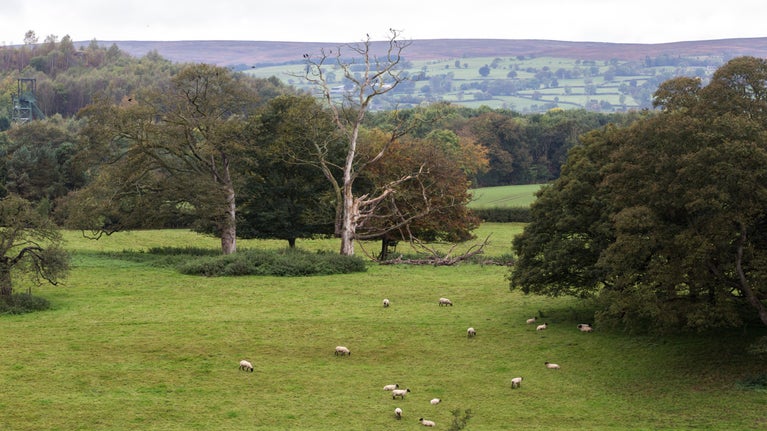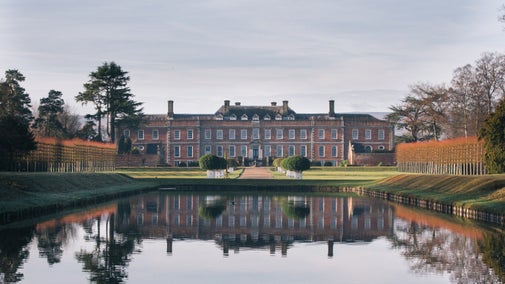
Discover more at Erddig
Find out when Erddig is open, how to get here, the things to see and do and more.

With a diverse parkland, Erddig is brimming with grassland, lakes, ponds, rivers, veteran trees and woodland. Discover scenery that ranges from the Clywedog river and peaceful woodland landscape of Big Wood, to famous architectural features like the ‘cup and saucer’ and the dramatic escarpment that leads to Wat’s Dyke. Explore the remains of a Norman motte and bailey castle.
This ‘great expense and labour’ was largely the work of the well-respected landscape designer William Emes who worked at Erddig from 1768-1780. He was contracted to not only create an aesthetically attractive landscape but also to increase the agricultural value of the land by reducing the serious flooding of the Afon Clwedog.
Emes created gravelled walks throughout the large pleasure grounds, planted many trees which are still thriving today, and manipulated the flow of water across the park through a series of cascades and weirs.
His most unique alteration to the Erddig landscape was the Cup and Saucer waterfall. This feature, which you can still see today, works by gathering water in a shallow circular stone basin with a cylindrical waterfall at its centre. The water falls through this cascade and then emerges from a tunnel several yards downstream.
Emes also incorporated into his designs some of the early earthwork features at Erddig for example the Motte and Bailey castle and Wat’s Dyke, a 40-mile long defensive earthwork built in the 8th century.
The Motte and Bailey Castle was built by the Normans in the 11th century to enforce their control over the local area. Explore the remains, which today are raised earthen mounds, covered by trees. Originally, this would have dominated the skyline. In its construction, the Normans utilised the natural topography of the land and the pre-existing defensive boundary of Wat’s Dyke.
Seven hundred years later, Emes incorporated these earthworks into his designs, planting an avenue of trees on its summit named cathedral aisle. Let your eyes follow and discover how the trees lead to a spectacular view over the surrounding landscape.
For over 300 years visitors have been invited to explore the parkland at Erddig. The Yorkes didn’t want to keep the estate to themselves, appreciating the value of the countryside to the health and wellbeing of the local community. In 1779, Philip Yorke I put up the following notice at the entrance lodges at Erddig:
Philip Yorke I
Erddig parkland is one of the best places in the UK for its ancient and notable trees. These include oak, sycamore, beech, sweet chestnut, ash, lime, hornbeam and hawthorn. There is an abundance of ancient oaks at Erddig, approximately 150 trees at the last count.
An ancient tree is a tree which is remarkably old for its species and this can vary dramatically. For example, birch trees are considered ancient at 150 years, oak at 400 years and yew trees an astonishing 800 years.
The Clywedog River and Black Brook that run through the estate carry many different fish species, as well as eels and water voles. Otters also travel through and visit Erddig, but these elusive creatures remain one of the hardest to spot.
Herons can often be seen patrolling the rivers and our rangers often spot dippers playing in the rapids. If you’re lucky, you may even catch a glimpse of our elusive kingfishers!
With over 30 ponds on our estate, Erddig has a very healthy variety of wetland habitats to suit a wide range of aquatic species from dragonflies to swans. Grass snakes like to hang out in these areas too, but don’t worry, they’re totally harmless.
See Erddig and the surrounding parkland from above https://www.youtube.com/watch?v=eCflRkbfwtg

Find out when Erddig is open, how to get here, the things to see and do and more.
Erddig is a two pawprint rated place. Erddig offers plenty of opportunities for bounding, jumping, sniffing and splashing for dogs. Find out about our off-lead zone and restricted access which might affect your plans.

From daffodils in spring to 180 apple varieties in autumn, find out about this 18th-century walled garden and its seasonal activities and highlights.

Check out the places to eat and shop at Erddig. Most are set within historic outbuildings and every purchase helps us to look after Erddig for future generations to enjoy.

Find out about the High Sheriff who lived beyond his means when he built Erddig, the rich London lawyer who extended and redecorated it and 240 years of the Yorke family.
